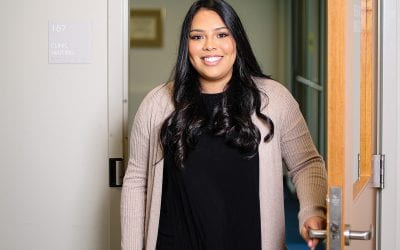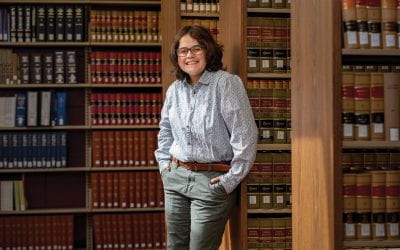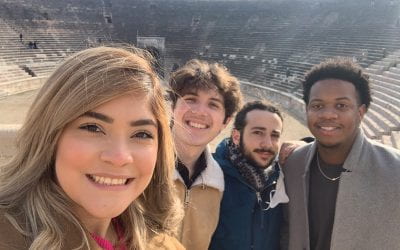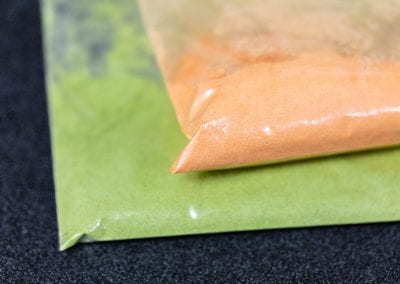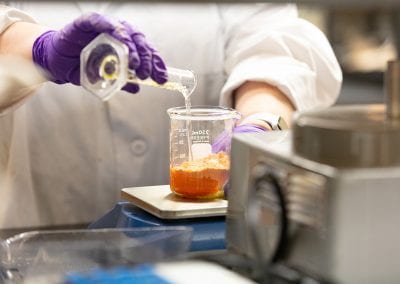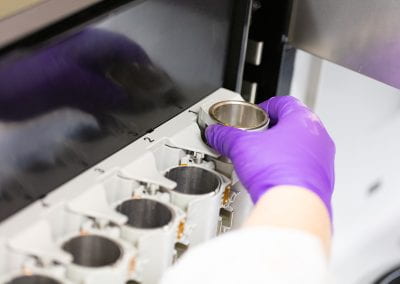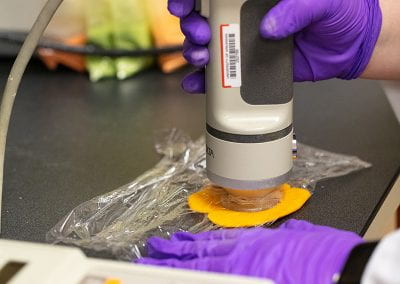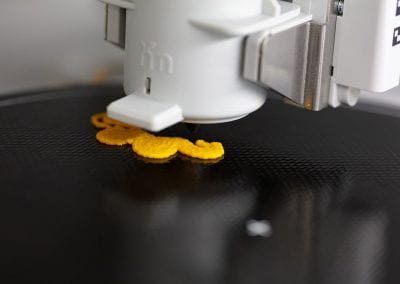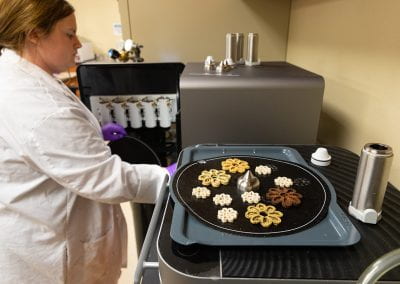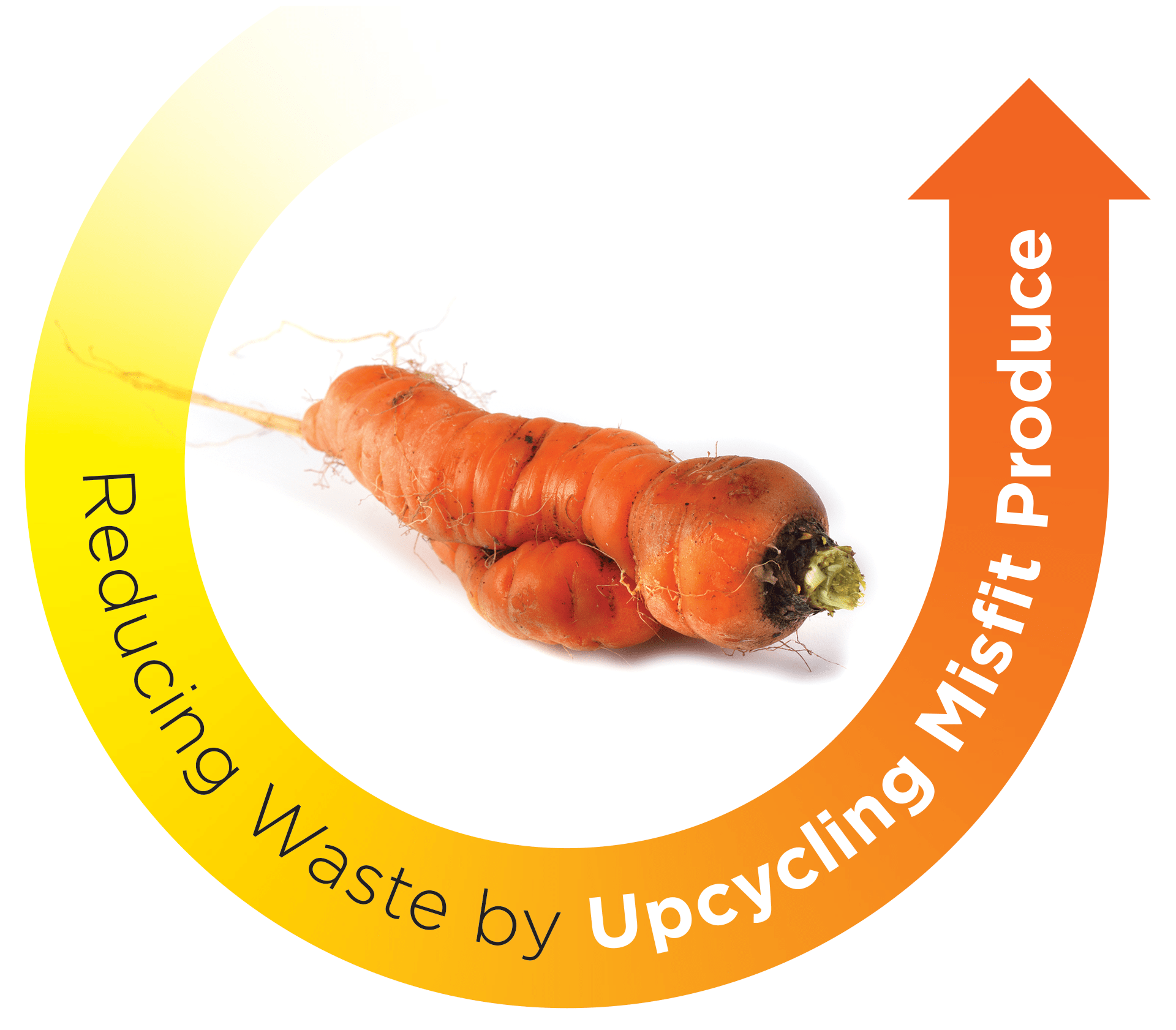
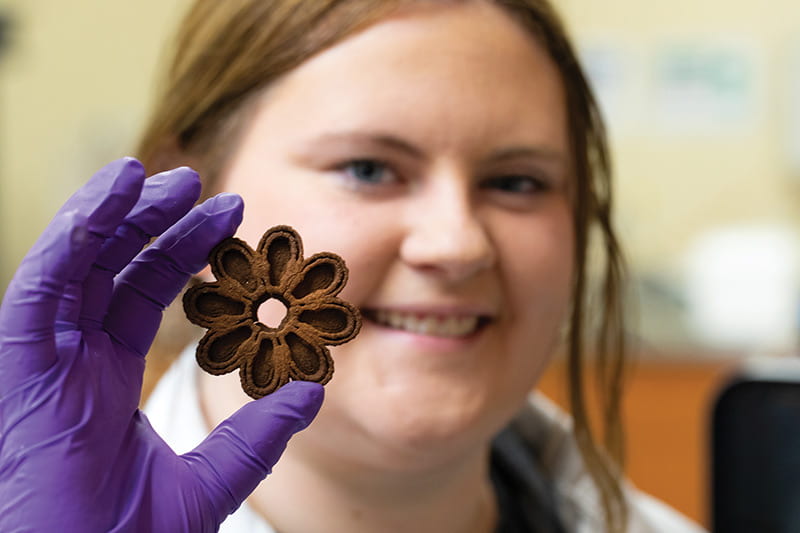
Taylor Clary freeze dries carrots and broccoli donated from local farms to create the mixture, which is extruded from the 3D printer and then baked in an oven to reimagine the produce as a crunchy snack with a longer shelf life.
By CD Eskilson / Photos by Russell Cothren and Cheiko Hara
Ugly tomatoes, odd-shaped carrots, weird-looking heads of cauliflower. Most consumers are conditioned to steer clear of produce with imperfections, though it is perfectly safe to eat. This mentality leads to high levels of food loss in our society where literal tons of misfit fruits and vegetables are tossed into landfills. In fact, the U.S. Department of Agriculture estimates that 31 percent of food is ultimately lost at both the retail and consumer levels.
“There’s a ridiculous amount of ugly or imperfect fruits and vegetables that aren’t seen as something that can be put onto our shelves,” said Taylor Clary, a senior honors student from Wichita, Kansas, studying food science and nutrition. She added that many of these imperfect products don’t even make it to our stores. “If a fruit or vegetable doesn’t look as pretty, producers don’t want to sell it because they know it won’t get picked.”
Clary is serious about cutting down food waste. Her honors thesis researched how to utilize this imperfect produce by creating 3D-printed snacks. By converting misfit carrots and broccoli into different shapes, she hopes to create a shelf-stable and sustainable alternative to landfills piling up with produce.
“I thought that we could basically reduce vegetables down to a form that nobody sees,” Clary explained. “That way, people won’t know what imperfections are there. You just recreate something, and that snack can have a cool shape or design.”
To make the snacks, Clary first freeze-dried imperfect carrots and broccoli donated from Taylor Farms. These were then ground down into powders to make them less susceptible to spoiling.
“The shelf life of the product is extended to about 25-30 years after it’s freeze-dried, and that makes it easier to have a constant stash of it,” she detailed. The vegetable powders are mixed with flour, olive oil, salt and water to form a paste. An extrusion-based 3D food printer shaped the paste into designs, which are then baked. The resulting snack is similar to a cracker.
Clary noted that while these snacks are low in ingredients, it took many attempts to perfect the paste so that it could be 3D printed. Multiple factors had to be considered and tested, including its ability to be extruded from the printing nozzle, having sufficient viscosity for layers to stack and keeping its shape and definition while baking. “The whole process of formulating the actual product was pretty difficult and challenging,” she said.
Nevertheless, Clary found this painstaking research to get to the right formula taught her about the patience required when developing new food products, something she hopes to pursue further. “I really think that this project has helped me learn more about the whole process of research and development,” she noted. After graduation, Clary will work as quality assurance team advisor trainee for Schreiber Foods and hopes to pursue a master’s degree later on as well.
Though 3D printing snacks might seem unusual at first, the technology has been growing more prominent throughout the food industry. Clary explained that it offers the customization of food products and the regulation of their nutritional value. She discovered 3D printing food through her thesis advisor Ali Ubeyitogullari, an assistant professor in food science and agricultural engineering. He highlighted the opportunity to promote sustainability through projects like Clary’s.
“3D food printing has the potential to revolutionize the way food is produced,” said Ubeyitogullari. “With Taylor’s project, our goal is to contribute towards reducing food loss and waste through upcycling imperfect vegetables into healthy and nutritious food products.”
Ubeyitogullari also noted that the technology continues to be refined to allow for customizable food products. “3D food printing offers higher flexibility and precision compared to traditional food production technologies, enabling personalized nutrition,” he said. “In the near future, we anticipate advancements in the functioning of 3D food printers to better handle post-processing steps.”
Clary is enthusiastic about the broader efforts to combat food waste through upcycled snacks and products. While her own snacks are still in development, she has been thrilled to find out other brands are getting imperfect foods onto our shelves. “The other day at the grocery store, there was a sweet potato chip that used ugly or imperfect vegetables,” she recalled. “I was like, ‘No way! This is so cool.’ I had to get a bag because it’s my project but in chip form,” said Clary.
More Field Notes
A Loss of Words
Karina Escobar is continuing her education in communication sciences and disorders and begins her master’s program this fall at the U of A. By Shelby Gill / Photos by Xavier Smith Karina Escobar discovered her college major on her 16th birthday, but that wasn’t the...
Service-Oriented Software
By CD Eskilson / Photos by Russell Cothren A 2022 report from the Governor’s Food Desert Working Group found that over 20 percent of Arkansas households reported facing some form of food insecurity, exceeding the national average of around 10 percent. Additionally,...
Expanding Equality with Human Rights Frameworks
Expanding Equality with Human Rights Frameworks By CD Eskilson Photos by Russell Cothren In the past decade, countries in Latin America have gained international recognition for working to expand LGBTQ+ rights. From Mexico to Argentina, new laws have passed to...
A Push to Pin Down Safety on the Razorback Greenway
Jessica Shearman likes to walk or ride her bike on the Razorback Greenway, particularly on the section that is close to Dickson Street and the Fayetteville Public Library. There is ample street lighting, and the trail is often busy with other commuters. The Razorback...
Pasta and a Broadening World View
Nayeli Ortiz doesn’t like pasta, but that didn’t stop her from studying abroad for an entire semester in Italy. “Funny story,” Ortiz laughs. “I don’t like pasta. I told myself to be open to new experiences, and every day, I would eat pasta.” While on campus, Ortiz...
Freeze drying
The carrots and broccoli are freeze-dried and then ground down into powders to make them less susceptible to spoiling.
Creating the mixture
The vegetable powders are mixed with flour, olive oil, salt and water to form a paste.
Extruding the mixture
Extrusion-based food printing is a digitally controlled process to build up complex 3D food products layer by layer.
Ensuring quality control
After forming the paste, a colorimeter is used to ensure quality consistency. Measuring the color of samples during food manufacturing verifies that products fall within the exact specified color tolerances.
Watch as a 3D printer extrudes up-cycled produce into a crunchy snack.



